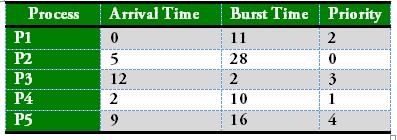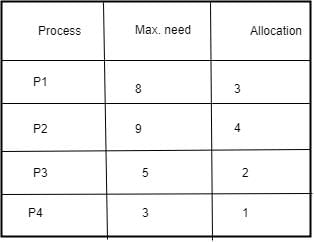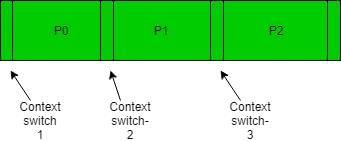Test: Threads- 2 - Computer Science Engineering (CSE) MCQ
20 Questions MCQ Test GATE Computer Science Engineering(CSE) 2025 Mock Test Series - Test: Threads- 2
Which of the following is/are not shared by all the threads in a process?
I. Program Counter
II. Stack
III. Registers
IV. Address space
Consider the set of processes with arrival time(in milliseconds), CPU burst time (in milliseconds), and priority(0 is the highest priority) shown below. None of the processes have I/O burst time.

The waiting time (in milliseconds) of process P1 using preemptive priority scheduling algorithm is ____.

Consider three CPU intensive processes, which require 10, 20, 30 units and arrive at times 0, 2, 6 respectively. How many context switches are needed if shortest remaining time first is implemented? Context switch at 0 is included but context switch at end is ignored
Two atomic operations permissible on Semaphores are __________ and __________.
User level threads are threads that are visible to the programmer and are unknown to the kernel. The operating system kernel supports and manages kernel level threads. Three different types of models relate user and kernel level threads. Which of the following statements is/are true ?
(a)
(i) The Many - to - one model maps many user threads to one kernel thread
(ii) The one - to - one model maps one user thread to one kernel thread
(iii) The many - to - many model maps many user threads to smaller or equal kernel threads
(b)
(i) Many - to - one model maps many kernel threads to one user thread
(ii) One - to - one model maps one kernel thread to one user thread
(iii) Many - to - many model maps many kernel threads to smaller or equal user threads
At particular time, the value of a counting semaphore is 10, it will become 7 after: (a) 3 V operations (b) 3 P operations (c) 5 V operations and 2 P operations (d) 2 V operations and 5 P operations Which of the following option is correct?
At a particular time of computation the value of a counting semaphore is 7. Then 20 P operations and xV operations were completed on this semaphore. If the new value of semaphore is 5 ,x will be
Names of some of the Operating Systems are given below:
(a) MS-DOS
(b) XENIX
(c) OS/2
In the above list, following operating systems didn’t provide multiuser facility.
One of the disadvantages of user level threads compared to Kernel level threads is
Consider a system having ‘m’ resources of the same type. These resources are shared by three processes P1, P2 and P3 which have peak demands of 2, 5 and 7 resources respectively. For what value of ‘m’ deadlock will not occur ?
Suppose there are four processes in execution with 12 instances of a Resource R in a system. The maximum need of each process and current allocation are given below:

With reference to current allocation, is system safe ? If so, what is the safe sequence ?
An Operating System (OS) crashes on the average once in 30 days, that is, the Mean Time Between Failures (MTBF) = 30 days. When this happens, it takes 10 minutes to recover the OS, that is, the Mean Time To Repair (MTTR) = 10 minutes. The availability of the OS with these reliability figures is approximately :
A CPU scheduling algorithm determines an order for the execution of its scheduled processes. Given 'n' processes to be scheduled on one processor, how many possible different schedules are there?
The state of a process after it encounters an I/O instruction is
A starvation free job scheduling policy guarantees that no job indefinitely waits for a service. Which of the following job scheduling policies is starvation free?
Which of the following strategy is employed for overcoming the priority inversion problem?
A disk drive has 100 cyclinders, numbered 0 to 99. Disk requests come to the disk driver for cyclinders 12, 26, 24, 4, 42, 8 and 50 in that order. The driver is currently serving a request at cyclinder 24. A seek takes 6 msec per cyclinder moved. How much seek time is needed for shortest seek time first (SSTF) algorithm?
|
55 docs|215 tests
|
|
55 docs|215 tests
|























